A route from history to the future
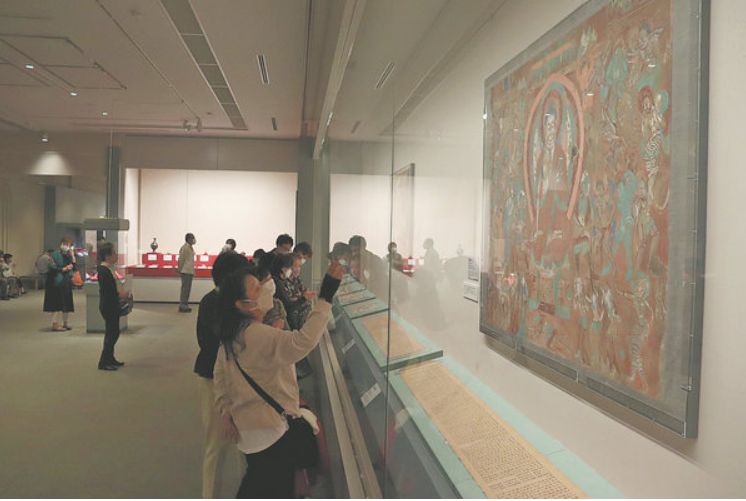
Visitors attend The Great Silk Road World Heritage Exhibition at the Tokyo Fuji Art Museum in Hachioji, Tokyo, on Oct 8. It is the first large-scale exhibition with the Silk Road as its theme to be held outside of China since 2014. [Photo by Kang Di/For China Daily]
Silk Road exhibition in Japan provides a rare opportunity to reaffirm the significance of this cultural heritage, report Jiang Xueqing in Tokyo and Wang Ru in Beijing.
The Great Silk Road World Heritage Exhibition, currently being held in Japan, is the first large-scale event with the Silk Road as its theme held outside of China since "Silk Roads: the Routes Network of Chang'an-Tianshan Corridor" was inscribed on the World Heritage List in 2014.
Hosted by the Tokyo Fuji Art Museum, Art Exhibitions China and The Asahi Shimbun, a daily newspaper in Japan, the exhibition features a selection of 237 precious artifacts related to the Silk Road from 27 major museums and academies in China, including those in the Xinjiang Uygur autonomous region and Dunhuang, Gansu province.
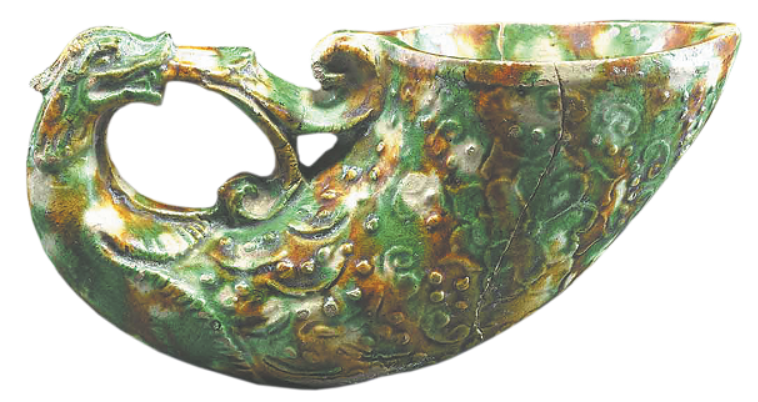
The items on display at the exhibition include gold and silver ornaments, bronze artifacts, ceramics, murals, paintings, textiles, and Buddhist scriptures and statues. [Photo provided to China Daily]
Among the items on display are silver ornaments, bronze artifacts, ceramics, murals, paintings, textiles, and Buddhist scriptures and statues. Many of them are being publicly displayed in Japan for the first time. Of these, 45 pieces are designated as first-class national cultural relics in China.
"The Silk Road-themed exhibition is being held for the third time in Japan. It was previously held once in the 1990s and again in 2004. After a gap of 18 years, which is roughly a generation, we feel it is necessary to hold another exhibition with the Silk Road as the theme to reaffirm the significance of this cultural heritage," says Chen Jianzhong, president of the Kouzan Finearts Company, the exhibition planning partner.
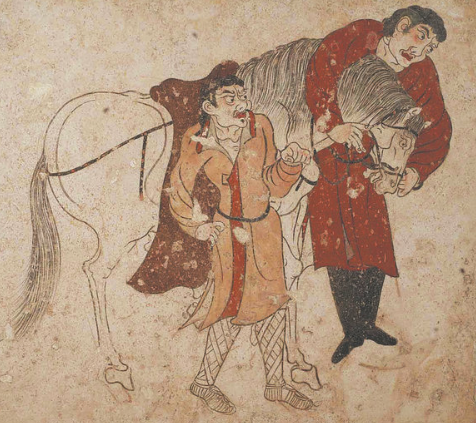
The items on display at the exhibition include gold and silver ornaments, bronze artifacts, ceramics, murals, paintings, textiles, and Buddhist scriptures and statues. [Photo provided to China Daily]
In 2014, the Chang'an-Tianshan Corridor, one of the major arteries of the historic route that opened up trade between China and the West, became the first stretch of the Silk Road to be inscribed on the UNESCO World Heritage List. The trans-boundary trading corridor, covering some 5,000 kilometers across China, Kazakhstan and Kyrgyzstan, was in active use from the second century BC until the 16th century, connecting cities, peoples and cultures across Central Asia, according to UNESCO.
The Silk Road represents the exchange of goods and trans-boundary communication-based interactions between people, says Akira Gokita, managing director and senior executive curator of the Tokyo Fuji Art Museum in Hachioji, in the western part of Tokyo.
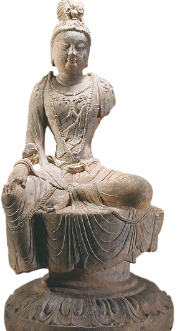
The items on display at the exhibition include gold and silver ornaments, bronze artifacts, ceramics, murals, paintings, textiles, and Buddhist scriptures and statues. [Photo provided to China Daily]
Daisaku Ikeda, the founder of the museum, advocated for "establishing a Silk Road of the mind". This exhibition not only displays the changes in people and goods in ancient times, but also hopes to establish a Silk Road in people's hearts and use it as a way to address some of the issues in modern society. If the exhibition can create a consciousness of seeking world peace and unity, it will be very gratifying, Gokita says.
"Through this exhibition, I have come to appreciate the broad-mindedness that the Silk Road embodies, the ability to accept and exchange various cultures, treating people of different races equally, and allowing for diversity and inclusiveness," he says, adding such broad-mindedness, diversity and inclusiveness are qualities that modern people should possess.
"I hope that when people think of the Silk Road, they don't see it as a distant, unrelated concept from far away, but rather as a spirit represented in everyone's heart. If people embrace the spirit of the Silk Road, it can become an opportunity for mutual exchange when addressing various social issues, promoting broader interactions and communication," he says.
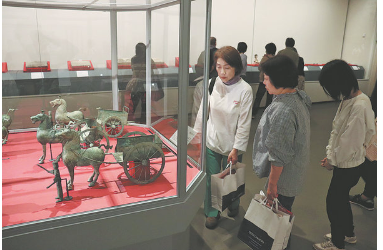
The exhibition was originally scheduled for 2020 but was postponed for three years due to COVID-19.
Between 2018 and 2019, a team of Japanese and Chinese experts visited major museums in 11 provinces and autonomous regions in China to select artifacts. They conducted three research trips, each lasting about two weeks, covering a total distance of 20,000 kilometers.
Ensuring safety of the artifacts was another big challenge. According to Wang Zhuoran, a curator of the exhibition from Art Exhibitions China, the various exhibits include heavy sculptures and tiny decorations, each requiring different protection when people move, preserve and display them.
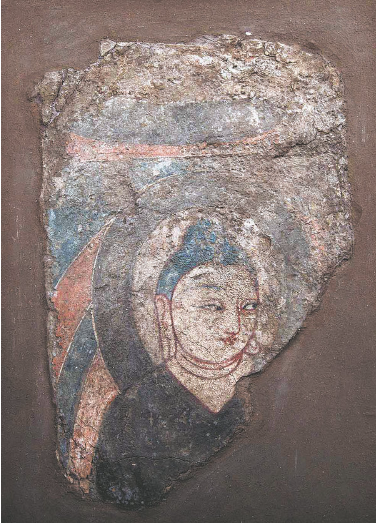
The items on display at the exhibition include gold and silver ornaments, bronze artifacts, ceramics, murals, paintings, textiles, and Buddhist scriptures and statues. [Photo provided to China Daily]
"As a result, we invested great patience in checking and recording the preservation and features of each exhibit, and trying to figure out ways of packaging and displaying that will protect the cultural relics and put them into practice with our Japanese colleagues. We have tried our best to reduce the risk of the artifacts being broken," says Wang.
During the preparation of this exhibition, whenever the Japanese experts saw the cultural artifacts, they couldn't help but think of the treasures preserved in Shosoin, the treasure house of Todaiji Temple in the city of Nara.
"The cultural artifacts in Shosoin and those from the Silk Road share many similarities, making us feel a sense of closeness and amazement. We believe that the cultural artifacts in Shosoin must have originated from the Silk Road. Through this exhibition, we aim to show the audience where these artistic treasures in Japan come from," Gokita says.
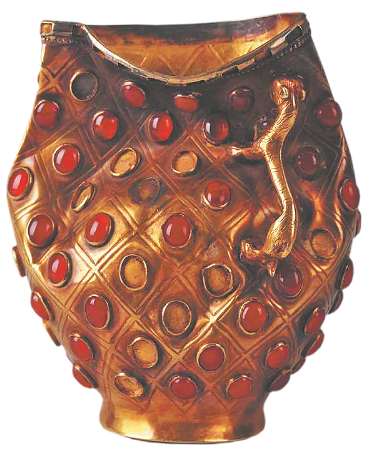
The items on display at the exhibition include gold and silver ornaments, bronze artifacts, ceramics, murals, paintings, textiles, and Buddhist scriptures and statues. [Photo provided to China Daily]
Hiroko Matsukawa, a 74-year-old woman living in the city of Akishima, visited the Xinjiang Uygur autonomous region 10 years ago. She went to see the exhibition on Oct 3 and was amazed.
"European culture spread to Asia through the Silk Road and then made its way to Japan. I believe the reason Japanese culture is what it is today is that, in the past, China pioneered the Silk Road, which led to the transmission and continuity of culture," Matsukawa says.
Tomoko Fudeyasu, a resident of Yamanashi prefecture, says she experienced the changing colors of different eras in China after viewing the exhibition.
"I was particularly impressed by the use of green in the exhibits. Furthermore, after seeing sculptures and other items on display, I felt the depth of the distinct cultures of each era. This exhibition has once again reminded me of the importance of communication between people and the significance of cultural heritage," Fudeyasu says.
Artifacts are evidence of civilization and it is important to let them speak, let them recount the history of the Silk Road, and allow the audience to grasp the spirit of the Silk Road through them, says Chen of the Kouzan Fine-arts Company.
These artifacts not only showcase the way of life along the Silk Road, but also reveal their cultural essence to the audience. For example, there is a gold cup, unearthed in Xinjiang, that has the shape of a Western goblet, but the decorative elements on the cup are entirely Chinese, reflecting the lifestyle of Chinese nomads and featuring Tang Dynasty (618-907) patterns.
"From this cup, we can see the importance of a fusion of multiple civilizations," says Chen.
The Tokyo Fuji Art Museum has previously collaborated with Chinese partners to host exhibitions with themes like "the Three Kingdoms" and "the Palace Museum", which attracted 1.01 million and 1.07 million visitors respectively. It is estimated that the ongoing exhibition will receive 800,000 to 1 million visitors.
The exhibition will be held at the Tokyo Fuji Art Museum until Dec 10 and is planned to tour other venues from January 2024 to February 2025, including the Fukuoka Asian Art Museum, the Tohoku History Museum, the Ehime Museum of Art, the Okayama Prefectural Museum of Art, and the Museum of Kyoto.
"Every time we host exhibitions related to traditional Chinese culture in Japan, they receive wide recognition. The Japanese audience deeply understands that hundreds or thousands of years ago, Japan and China had such a relationship, and the source of Japanese culture can actually be found in China. From the bottom of their hearts, they have an appreciation for China, which strengthens their feelings toward the country," Chen says.
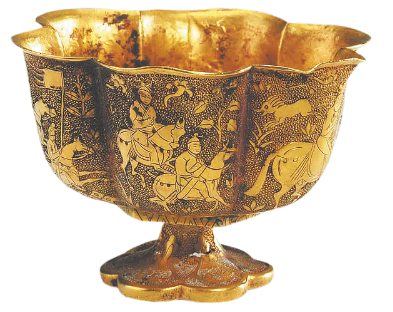
The items on display at the exhibition include gold and silver ornaments, bronze artifacts, ceramics, murals, paintings, textiles, and Buddhist scriptures and statues. [Photo provided to China Daily]
Japan has been doing research on the Silk Road for a long time. Soka University has a Silk Road research center that has conducted extensive research and investigations related to the Silk Road. Many other universities in Japan also have Silk Road research institutes. Some specialize in excavating ancient relics and making new discoveries, while others excel in analyzing silk or studying existing artifacts, such as Buddhist statues, says Gokita of the Tokyo Fuji Art Museum.
In the 1980s, NHK, a Japanese public broadcaster, aired a television program about the Silk Road, which sparked interest among nonprofessionals in Japan. This created a wave of enthusiasm nationwide and brought Japanese people closer to the Silk Road, Gokita says.
"Some of the emerging Silk Road researchers at that time, through writing books and papers, elevated the study of the Silk Road in Japan to new heights. However, many of these researchers are now elderly, and it appears that the Silk Road research in Japan is in a period of transition from the old to the new generation," he says.
Editor:赵慧俊
